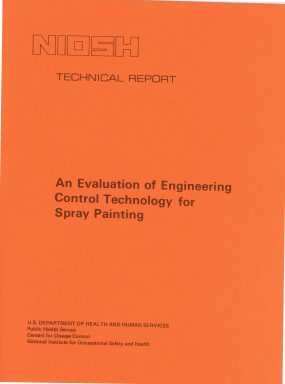An Evaluation of Engineering Control Technology for Spray Painting
June 1981
DHHS (NIOSH) Publication Number 81-121

A NIOSH survey for the evaluation of control technology for spray painting and coating processes is reviewed. Walk through surveys of 19 facilities were conducted, with 11 spray finishing processes studied. Considerations governing selection of the processes include coating type and toxicity, application techniques, engineering controls and work practices, personal protection equipment, product size and shape, substrate materials, and required finish and appearance. Classifications of industrial coatings are described by mechanism of their film formation, including thermoplastic and convertible binders. The major constituents of industrial finishes, binders, pigments volatile solvents, and additives are described. Tabulated data is presented for consumption of resins, pigments, and solvents from 1973 to 1977 and for each industry. The compressed air, airless, and electrostatic methods of spray application are discussed. Industrial finishing practices for automobile refinishing, wood furniture, metal furniture, major appliances, nonautomotive transportation, and machinery and equipment are discussed. Hazards due to aluminum (7429905), barite (61026413), calcium (7440702), chromium (7440473), lead (7439921), silica (7631869), silicates, titanium-dioxide (13463677), zinc (7440666), zinc-oxide (1314132), organic pigments, acrylic resins, alkyds, amino resins, cellulose resins, epoxy resins, urethane (51796), vinyl resins, alcohols, esters, glycols, ketones, petroleum distillates, toluene (108883) xylene (1330207), paint driers, and plastizers are discussed. Control of health hazards by substitution of materials or equipment or by isolation or changes in ventilation also is described. The results of air sampling are included. The authors recommend the use of paints that contain relatively nontoxic materials and a minimum amount of solvent, spray booths with proper ventilation, and application equipment that will minimize the amount of spray mist generated. They also recommended further studies on health and respiratory protection and the improvement of material safety data sheets provided with the coating.
An Evaluation of Engineering Control Technology for Spray Painting [PDF – 13 MB]
- Page last reviewed: April 5, 2017
- Page last updated: June 27, 2017
- Content source:
- National Institute for Occupational Safety and Health Education and Information Division


 ShareCompartir
ShareCompartir